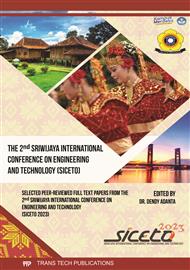[1]
R. W. van Bemmelen and I. T. A.-T. T. -, "The geology of Indonesia." Govt. Print. Off.; sole agents, Nijhoff The Hague, The Hague, 1949. doi: LK - https://worldcat.org/title/624477880.
Google Scholar
[2]
M. Alzwar, N. Akbar, and S. Bachri, "Peta Geologi Lembar Garut dan Pameungpeuk." Geological Research and Development Center, Bandung, Indonesia, 1992.
Google Scholar
[3]
R. G. Intani et al., "Improving the conceptual understanding of the Darajat Geothermal Field," Geothermics, vol. 83, no. December 2018, p.101716, 2020.
DOI: 10.1016/j.geothermics.2019.101716
Google Scholar
[4]
P. Supendi, A. D. Nugraha, N. T. Puspito, S. Widiyantoro, and D. Daryono, "Identification of active faults in West Java, Indonesia, based on earthquake hypocenter determination, relocation, and focal mechanism analysis," Geosci. Lett., vol. 5, no. 1, 2018.
DOI: 10.1186/s40562-018-0130-y
Google Scholar
[5]
P. Supendi, A. D. Nugraha, and S. Widiyantoro, "Recent destructive earthquakes around Garut area, West Java, Indonesia: An unidentified fault?," AIP Conf. Proc., vol. 1987, p.1–7, 2018.
DOI: 10.1063/1.5047362
Google Scholar
[6]
Y. Morishita, "Nationwide urban ground deformation monitoring in Japan using Sentinel-1 LiCSAR products and LiCSBAS," Prog. Earth Planet. Sci., vol. 8, no. 1, 2021.
DOI: 10.1186/s40645-020-00402-7
Google Scholar
[7]
Y. Morishita, M. Lazecky, T. J. Wright, J. R. Weiss, J. R. Elliott, and A. Hooper, "LiCSBAS: An open-source insar time series analysis package integrated with the LiCSAR automated sentinel-1 InSAR processor," Remote Sens., vol. 12, no. 3, p.5–8, 2020.
DOI: 10.3390/rs12030424
Google Scholar
[8]
A. Putri, M. S. Purwanto, and A. Widodo, "IDENTIFIKASI PERCEPATAN TANAH MAKSIMUM (PGA) DAN ERENTANAN TANAH MENGGUNAKAN METODE MIKROTREMOR I JALUR SESAR KENDENG," Geosaintek, vol. 03, no. 2, p.107–114, 2017.
DOI: 10.12962/j25023659.v3i2.2966
Google Scholar
[9]
C. H. Scholz, Earthquakes: The Mechanics of Earthquakes and Faulting. New York: Cambridge University Press, 2002.
DOI: 10.1126/science.250.4988.1758.b
Google Scholar
[10]
M. J. Rickard, "Fault classification: Discussion," Bull. Geol. Soc. Am., vol. 83, no. 8, p.2545–2546, 1972, doi: 10.1130/0016-7606(1972)83[2545:FCD]2.0.CO;2.
DOI: 10.1130/0016-7606(1972)83[2545:fcd]2.0.co;2
Google Scholar
[11]
I. M. Anjasmara, S. A. Yulyta, and M. Taufik, "Application of time series InSAR (SBAS) method using sentinel-1A data for land subsidence detection in Surabaya city," Int. J. Adv. Sci. Eng. Inf. Technol., vol. 10, no. 1, p.191–197, 2020.
DOI: 10.18517/ijaseit.10.1.6749
Google Scholar
[12]
P. Castellazzi and W. Schmid, "Interpreting C-band InSAR ground deformation data for large-scale groundwater management in Australia," J. Hydrol. Reg. Stud., vol. 34, no. February, p.100774, 2021.
DOI: 10.1016/j.ejrh.2021.100774
Google Scholar
[13]
I. Arisbaya et al., "Garsela Fault and other NE-SW active faults along the southern part of Java Island," IOP Conf. Ser. Earth Environ. Sci., vol. 789, no. 1, p.0–7, 2021.
DOI: 10.1088/1755-1315/789/1/012065
Google Scholar
[14]
G. Santoso, "Laporan Dan Rekomendasi Teknis Tahap 2 Gempa Bumi Garut Tanggal 1 Februari 2023," PVMBG, 2023. https://vsi.esdm.go.id/laporan-singkat/laporan-dan-rekomendasi-teknis-tahap-2-gempa-bumi-garut-tanggal-1-februari-(2023)
DOI: 10.31153/ppis.2019.22
Google Scholar
[15]
M. Khoiroh, Sulastri, B. Sunardi, and N. Latuconsina, "Analisis Bahaya Kegempaan Di Kabupaten Garut Dengan Percepatan Tanah Maksimum Menggunakan Metode Probabilistik," Semin. Nas. Kebumian Ke 11, p.1161–1170, 2018.
Google Scholar
[16]
M. K. Rosyidi et al., "Integrated Surveying for the Archaeological," vol. 11, no. 2, p.39–50, 2021.
DOI: 10.21163/GT
Google Scholar
[17]
Yulaikhah, S. Pramumijoyo, N. Widjajanti, and A. Widagdo, "Optimal design of the Sermo Fault deformation monitoring network using sensitivity criteria based on geological information," Arab. J. Geosci., vol. 14, no. 20, 2021.
DOI: 10.1007/s12517-021-08411-6
Google Scholar
[18]
G. I. Marliyani, J. R. Arrowsmith, and K. X. Whipple, "Characterization of slow slip rate faults in humid areas: Cimandiri fault zone, Indonesia," J. Geophys. Res. Earth Surf., vol. 121, no. 12, p.2287–2308, 2016.
DOI: 10.1002/2016JF003846
Google Scholar
[19]
I. Rusydy, K. Jamaluddin, E. Fatimah, F. Andika, and Y. Furumoto, "Estimation of Site Amplifications from Shear-Wave Velocity at Pyroclastic deposits and Basins in Aceh Tengah and Bener Meriah District , Aceh Province , Indonesia," Int. J. Disaster Manajement, vol. 1, no. 1, p.46–54, 2017.
Google Scholar


